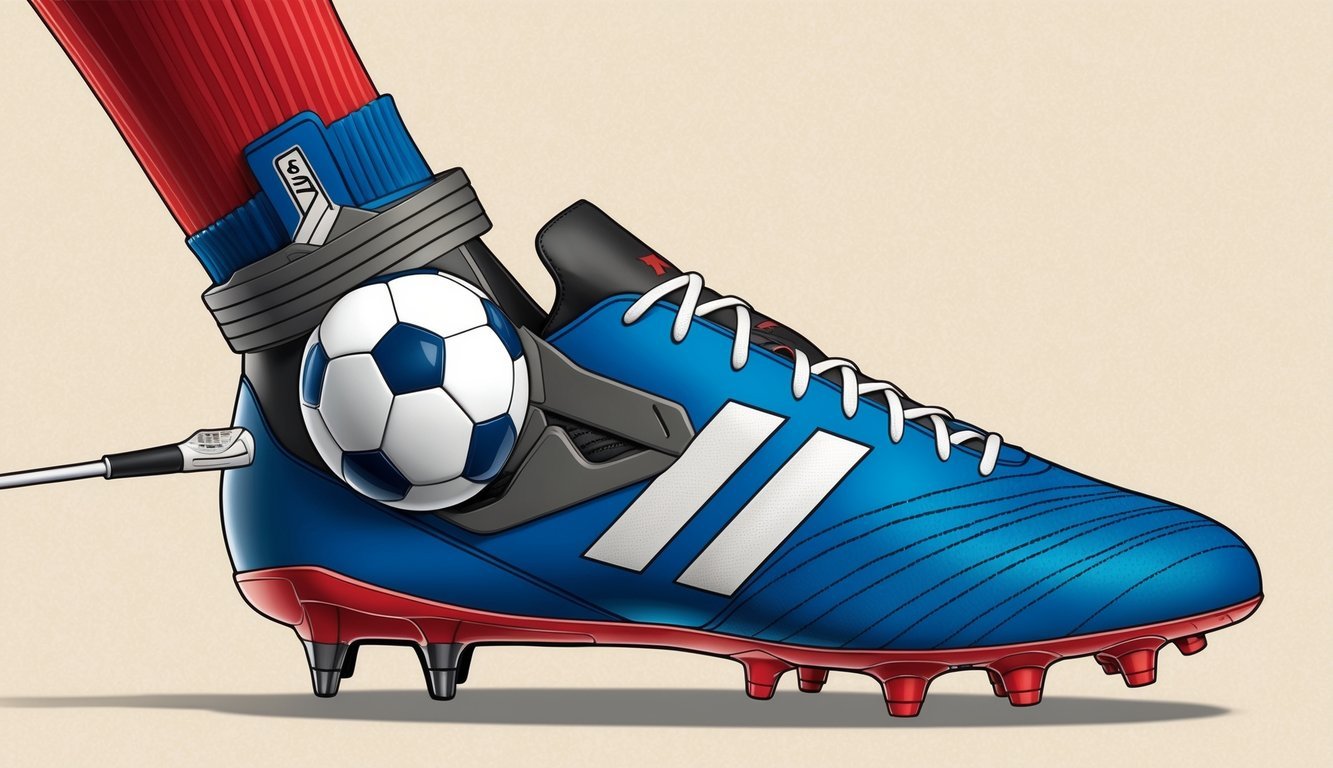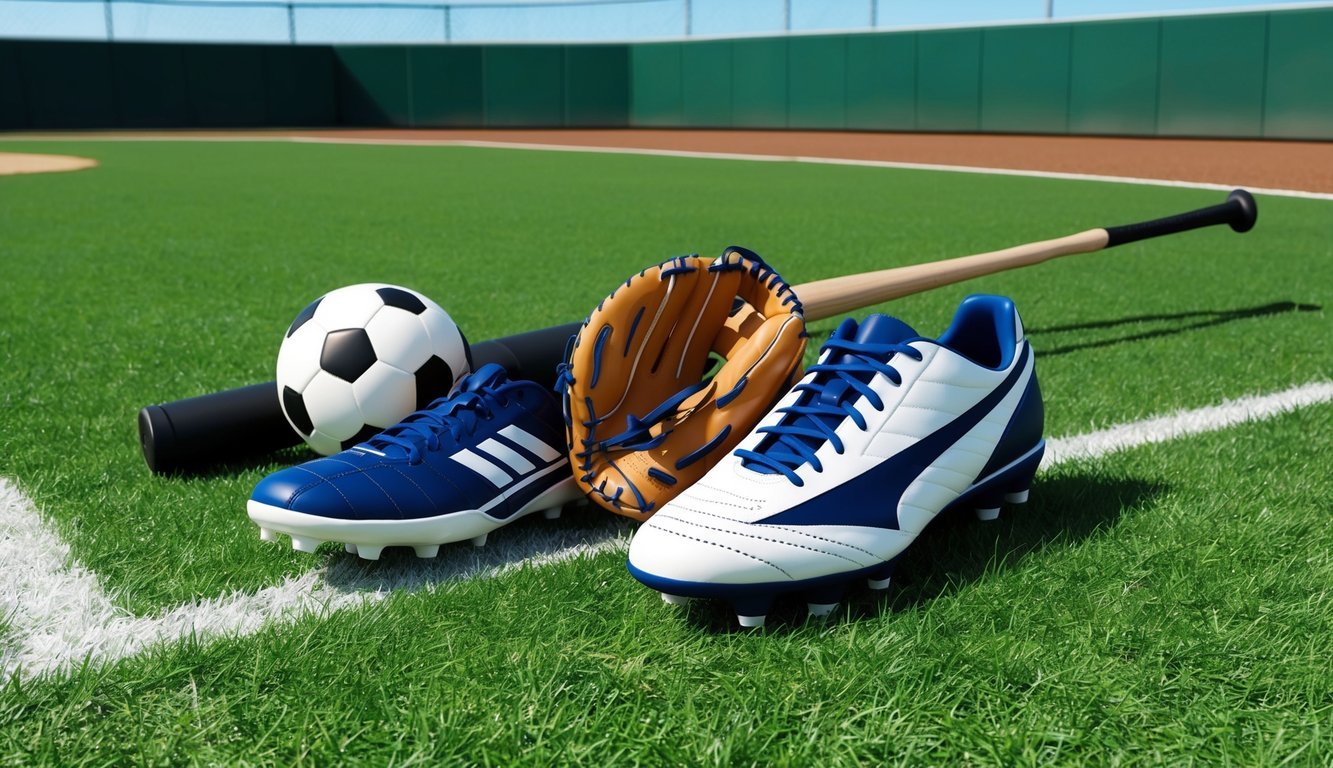Baseball and soccer may seem like very different sports, but they share one common element – the need for specialized footwear.
Many players wonder if they can use soccer cleats for baseball, especially when starting out or in a pinch.
Soccer cleats and baseball cleats have distinct designs tailored to their respective sports.
Baseball cleats typically feature a toe cleat and longer studs for better traction when running bases and fielding.
Soccer cleats, on the other hand, lack the toe cleat and have a different stud pattern optimized for quick movements on grass.
For young players or those just starting out, using soccer cleats for baseball may be acceptable temporarily.
However, as players advance and the demands of the game increase, proper baseball cleats become essential for optimal performance and reducing the risk of injury.
Investing in sport-specific footwear ensures players have the right tools to excel on the field.
Understanding the Differences Between Cleats
Soccer and baseball cleats have distinct features tailored to their respective sports.
These differences impact performance, safety, and comfort on the field.
Design and Material Variations
Soccer cleats prioritize lightweight construction and ball control.
They’re typically made from synthetic materials or leather, offering a snug fit.
The upper part is designed to enhance touch and feel when kicking the ball.
Baseball cleats, on the other hand, focus on durability and stability.
They often use tougher materials like leather or synthetic blends to withstand sliding and quick directional changes.
Some baseball cleats incorporate metal spikes for superior traction on dirt and grass.
The weight difference is noticeable.
Soccer cleats are generally lighter to promote agility and quick movements.
Baseball cleats may be slightly heavier due to their more robust construction.
Sole Structure and Traction Features
Soccer cleat soles are designed for grass surfaces.
They have multiple short, evenly distributed studs to provide grip while allowing quick pivots and turns.
The studs are usually made of molded plastic or rubber.
Baseball cleat soles differ significantly.
They feature a distinct pattern with studs or spikes arranged to support forward motion and sudden stops.
A key feature is the toe cleat, which provides extra grip for pushing off when running bases.
Metal spikes are common in baseball cleats, especially at higher levels of play.
These offer superior traction but aren’t allowed in soccer due to safety concerns.
Ankle Support and Cleat Height
Soccer cleats come in low-top designs to maximize ankle mobility.
This allows for quick footwork and precise ball control.
The low profile helps players feel the ball better when dribbling or passing.
Baseball cleats offer more variety in terms of ankle support.
They come in low-top, mid-top, and high-top options.
High-tops provide extra ankle stability for lateral movements and quick direction changes common in baseball.
The added support in baseball cleats can be beneficial for players who need extra ankle protection.
However, it may slightly reduce flexibility compared to soccer cleats.
The Role of Cleats in Athletic Performance
Cleats play a crucial role in enhancing athletic performance on the baseball field.
They provide traction, stability, and support for players during various movements and actions.
Influence on Speed and Agility
Baseball cleats are designed to boost speed and agility.
The stud pattern on the outsole helps players grip the ground, allowing for quick starts and stops.
This traction is essential for base running and fielding.
Cleats also aid in lateral movements, which are common in baseball.
Infielders benefit from the added stability when moving side-to-side to field ground balls.
For outfielders, cleats provide the necessary grip for sudden bursts of speed when chasing fly balls.
The right cleats can make a significant difference in a player’s ability to accelerate and change direction rapidly.
Player Position and Specific Needs
Different positions in baseball require varied cleat designs.
Pitchers, for example, need cleats that offer excellent stability during their delivery.
A toe cleat provides extra grip during the push-off phase of pitching.
Catchers benefit from cleats with ankle support due to their frequent squatting and quick movements.
Infielders often prefer low-cut cleats for increased mobility when fielding ground balls.
Outfielders may opt for cleats with a mix of molded and metal studs for versatility in different field conditions.
This combination allows for optimal traction during long runs and sudden stops.
Batters look for cleats that provide a solid foundation in the batter’s box.
Good traction helps them maintain balance and generate power during their swing.
Safety Considerations and Injury Prevention
Wearing the right cleats is crucial for player safety and performance on the baseball field.
Proper footwear helps prevent injuries and provides stability on various playing surfaces.
Proper Fit and Protection
Baseball cleats should fit snugly to prevent blisters and provide ankle support.
A good fit reduces the risk of trips and falls during quick movements.
Look for cleats with reinforced toe boxes to protect against impacts from balls or collisions.
Cleats with molded plastic spikes offer a balance of traction and safety on most surfaces.
Metal spikes provide excellent grip but may be restricted in some leagues due to injury risks.
Padding around the ankle and heel area cushions impacts and helps prevent sprains.
Some players prefer high-top designs for extra ankle protection, especially on uneven infields.
Identifying Potential Risks on Playing Surfaces
Different field conditions require adjustments in cleat selection.
On wet grass, longer metal or molded spikes provide better traction.
For dry, hard infields, shorter spikes work well without risking catching on the dirt.
Artificial turf presents unique challenges.
Cleats with numerous small studs distribute weight evenly and reduce stress on joints.
Avoid metal spikes on turf, as they can snag and cause knee or ankle injuries.
Natural grass outfields may have hidden dips or holes.
Players should inspect the area during warm-ups and choose cleats with good lateral support.
For multi-surface play, versatile cleats with a mix of molded studs work well.
This design adapts to both grass and dirt while minimizing injury risks from sudden changes in traction.
Adapting Soccer Cleats for Baseball

Soccer cleats can be adapted for baseball play with some adjustments and considerations.
While not ideal, they can serve as a temporary solution in certain situations.
Considerations for Transitioning Footwear
Soccer cleats lack the toe stud found on baseball cleats, which affects traction during batting and base running.
The soleplate design differs, potentially impacting stability on the diamond.
Comfort may vary, as soccer cleats are typically lighter and less supportive than baseball-specific footwear.
This could affect performance during long games or practices.
Durability is another factor to consider.
Baseball movements put different stresses on cleats compared to soccer, potentially leading to faster wear and tear.
Making the Most of Soccer Cleats on the Diamond
For outfielders, soccer cleats can be suitable due to their emphasis on running and lateral motion.
The lightweight design may even offer an advantage in terms of speed and agility.
When batting, players should be mindful of their footing and may need to adjust their stance slightly to compensate for the lack of a toe stud.
Wearing soccer cleats for baseball is best suited for casual play or as a temporary solution.
It’s not recommended for competitive games or long-term use.
To enhance comfort, consider adding extra insoles for better cushioning and support.
This can help mimic the feel of baseball cleats more closely.
Conclusion

Soccer cleats are not ideal for baseball.
The design differences make them less suitable for the diamond.
Soccer cleats typically have a flat outsole that is optimized for traction on grass, whereas baseball cleats are specifically designed with different stud patterns that provide better grip on the dirt and grass of a baseball diamond.
Additionally, baseball players often rely on equipment like the best batting gloves for comfort, which enhance grip and protect the hands during play.
Using soccer cleats can hinder a player’s performance and safety while navigating the unique challenges of a baseball field.
Baseball cleats offer better traction and stability on dirt and grass.
They have specialized studs for quick starts and stops.
Soccer cleats lack the front toe cleat crucial for baseball movements.
Their lightweight construction may not provide enough support.
Players should use the proper equipment for each sport.
Using the right cleats enhances performance and reduces injury risk.
Coaches recommend sport-specific footwear for optimal results.
While soccer cleats might work in a pinch, they’re not a long-term solution.
For the best experience on the baseball field, invest in proper baseball cleats.
They’re designed with the sport’s unique demands in mind.
Remember, the right tools make a big difference in any game.
Choose wisely and play your best!
